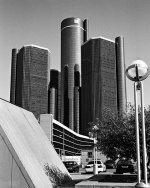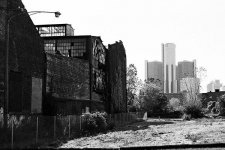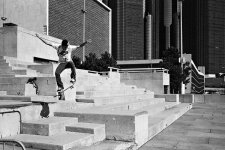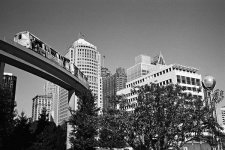MCTuomey
Veteran
Some pics from my first trial rolls. Developed and scanned by NCPS, taken at box speed with my M4-2 and mostly a C-Biogon 35 in harsh light. Is this the look you'd expect from this film, off the mark, needing help, etc.?
I'm looking to settle on a medium/slower speed B&W film for occasional but consistent use that'll give good results without involving home development or scanning. I wanted to try Delta 100 due to its reputation as a very high resolution, higher contrast, "modern" film somewhat more forgiving of exposure errors than, say, Tmax 100. Part of what I'm asking is whether the lab did well with this film.



I'm looking to settle on a medium/slower speed B&W film for occasional but consistent use that'll give good results without involving home development or scanning. I wanted to try Delta 100 due to its reputation as a very high resolution, higher contrast, "modern" film somewhat more forgiving of exposure errors than, say, Tmax 100. Part of what I'm asking is whether the lab did well with this film.
Attachments
Last edited:
MCTuomey
Veteran
titrisol
Bottom Feeder
Besides some cropping, those images look right!
The skateboarder image has a lot of potential
The skateboarder image has a lot of potential
Pirate
Guitar playing Fotografer
Nice shots. Looks like they came out just fine.
MCTuomey
Veteran
Thanks, Pirate and Titrisol. NCPS did a very nice job taking care with the negatives: clean, no scratches, etc. The scans are so much better than what I used to get from my Coolscan 4000.
Mister E
Well-known
NCPS is great! Nice shots too!
Pirate
Guitar playing Fotografer
I've been meaning to try NCPS but I enjoy developing myself too much.
Requin
Established
Nice photos. IMO I think your pix are too contrasty, though it's difficult to judge a picture on a PC monitor.
Do you plan to develop your film yourself? You can develop your film to the contrast you want.
Do you plan to develop your film yourself? You can develop your film to the contrast you want.
lawrence
Veteran
These look pretty much like D100 to me:
Here are a couple of my D100s, which I developed myself:
http://www.flickr.com/photos/lawrenceimpey/236150752/in/set-72157594272468960
http://www.flickr.com/photos/lawrenceimpey/394209552/in/set-72157594542464783/
- Sharp
- Fine grain
- Midtones quite contrasty
- Nice highlight gradation
Here are a couple of my D100s, which I developed myself:
http://www.flickr.com/photos/lawrenceimpey/236150752/in/set-72157594272468960
http://www.flickr.com/photos/lawrenceimpey/394209552/in/set-72157594542464783/
MCTuomey
Veteran
NCPS is great! Nice shots too!
Do you use them for 35mm silver B&W, Mister E?
Nice photos. IMO I think your pix are too contrasty, though it's difficult to judge a picture on a PC monitor.
Do you plan to develop your film yourself? You can develop your film to the contrast you want.
I prefer stronger contrast, Requin. Good point judging from a monitor - I plan to do some test prints. Re: development, no, for the volume I'll shoot I prefer to be able to use a lab.
These look pretty much like D100 to me:
- Sharp
- Fine grain
- Midtones quite contrasty
- Nice highlight gradation
Lawrence, that's what I'm looking to confirm, much appreciated. And thanks for posting the links - the comparison is very helpful (nice shots, btw). Your prison shot shows smoother tonal gradation, so does the Death Valley one. The former is likely due to conditions; my shots were taken in difficult nearly mid-day bright sun. You seem to be taming the light very well in the Death Valley pic. My shots, not so much. NCPS seems to be giving me at least a fair amount of the look one would expect from the film, though.
Last edited:
lawrence
Veteran
You seem to be taming the light very well in the Death Valley pic. My shots, not so much. NCPS seems to be giving me at least a fair amount of the look one would expect from the film, though.
Are you doing any post-processing? Personally I always find it essential to do some in Photoshop Elements 8. Normally I lighten the shadows just a little bit and adjust the brightness and contrast (there's an auto contrast facility in PSE8 which is very useful for getting a decent black -- I normally use this first, before making further adjustments).
MCTuomey
Veteran
Are you doing any post-processing? Personally I always find it essential to do some in Photoshop Elements 8. Normally I lighten the shadows just a little bit and adjust the brightness and contrast (there's an auto contrast facility in PSE8 which is very useful for getting a decent black -- I normally use this first, before making further adjustments).
I didn't do any on these scans purposely, other than resize at 72 ppi and save for web use. Nice to know what you do for Delta 100 - I'm going to work the files a bit with your suggestions and see what I discover. NCPS' scans are jpg only, so I'll have to keep the post-processing adjustments to a minimum.
lawrence
Veteran
I didn't do any on these scans purposely, other than resize at 72 ppi and save for web use. Nice to know what you do for Delta 100 - I'm going to work the files a bit with your suggestions and see what I discover. NCPS' scans are jpg only, so I'll have to keep the post-processing adjustments to a minimum.
You could save the JPGs as TIFFs and then work on them...
Chriscrawfordphoto
Real Men Shoot Film.
You could save the JPGs as TIFFs and then work on them...
That won't make a difference, the damage from saving as a JPEG is already done. For best results, you need 16 bit TIFFs from the beginning. Once you've converted to 8 bit, you've lost a lot of ability to post process without the tonality falling apart, and add to that the damage from JPEG compression. Lab scans just aren't worth it.
lawrence
Veteran
That won't make a difference, the damage from saving as a JPEG is already done.
If you are going to work on a file I think it's a good idea to convert into TIFF. Seems I'm not the only one who thinks this:
http://www.techsurvivors.net/forums/lofiversion/index.php?t8004.html
MCTuomey
Veteran
That's helpful, Lawrence, thanks. Anything I can do to lessen the effects of compression, I'll add to my workflow.
I hope you're not completely right about lab scans not being worth it, Chris. I want to be able to work with lab scans. I shoot film in a volume that doesn't make home development and scanning advantageous. I just don't do it frequently enough to do it well or confidently. Basically I risk screwing up film. Rather than screwing up rolls, I send it out. Volume is low, so cost isn't much of a factor.
Based on my judgment and the comments so far, I'm going to have some test prints made from the NCPS scans after a bit of post-processing and see what I get.
I hope you're not completely right about lab scans not being worth it, Chris. I want to be able to work with lab scans. I shoot film in a volume that doesn't make home development and scanning advantageous. I just don't do it frequently enough to do it well or confidently. Basically I risk screwing up film. Rather than screwing up rolls, I send it out. Volume is low, so cost isn't much of a factor.
Based on my judgment and the comments so far, I'm going to have some test prints made from the NCPS scans after a bit of post-processing and see what I get.
Mister E
Well-known
I love JPG. When I shot digital I shot exclusively JPG. I use NCPS for C-41, B&W and E-6. I even send my K-14 to them.
mathomas
Well-known
I like Delta 100, but I think it's too contrasty with high-contrast light and/or subjects. Your scans came out well, if a bit crispy for my taste. They basically look like my own lab results with Delta 100. When I use my lab, I've learned to ask them for TIFFs, no adjustments, no sharpening. I can always crisp them up myself, later  .
.
Richard G
Veteran
I agree with Mike Thomas. But your photos and scans look great. In the harsh Australian sun I would avoid looking for such high contrast. I like Rollei Retro 100 in this regard, although my lab frequently screws up the scan.
Steve M.
Veteran
Yep, that looks like Delta 100. I started using it in 120 because I was bored w/ FP4 and needed a slower speed film for times when Tri-X just wasn't right for the situation. At least for me, I found that it had a hard time coping w/ the harsh sun here in New Mexico, but I haven't used it enough to decide if I'm going to stay w/ it. It sure makes nice portraits though.
I haven't seen any issues w/ JPEG's vs TIFFs. To my understanding, if the JPEG is saved as a large file in PS, it can be opened and modified a lot of times before seeing any degradation that would in any way affect your prints. Once you open a file you can make all of the changes you wish, it's only when you open and close the files to modify them over and over that you might see cumulative damage, but again, I have never seen any degradation in my own files, and some of them have been modified many times.
I once did some tests and saved a scan as a JPEG, the rescanned the neg and saved it as a TIFF. Went to Photoshop and made a lot of changes in both, saved them, and made some prints. I didn't see one bit of difference either in the prints or the monitor images, so now I usually just save files as a JPEG to save space and once I get my final edit down save them as TIFFs..
I haven't seen any issues w/ JPEG's vs TIFFs. To my understanding, if the JPEG is saved as a large file in PS, it can be opened and modified a lot of times before seeing any degradation that would in any way affect your prints. Once you open a file you can make all of the changes you wish, it's only when you open and close the files to modify them over and over that you might see cumulative damage, but again, I have never seen any degradation in my own files, and some of them have been modified many times.
I once did some tests and saved a scan as a JPEG, the rescanned the neg and saved it as a TIFF. Went to Photoshop and made a lot of changes in both, saved them, and made some prints. I didn't see one bit of difference either in the prints or the monitor images, so now I usually just save files as a JPEG to save space and once I get my final edit down save them as TIFFs..
Share:
-
This site uses cookies to help personalise content, tailor your experience and to keep you logged in if you register.
By continuing to use this site, you are consenting to our use of cookies.




